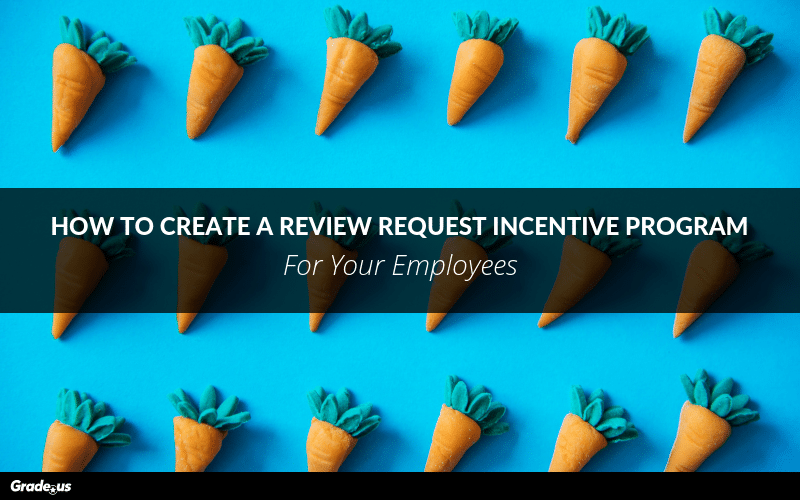Updated: 2/7/2022
Do your employees receive reviews like this?
Read Wendi’s NewLife N.‘s review of Valerie Furniture on Yelp
How do you motivate your employees to pursue customer reviews? Mobilizing employees isn’t a common review marketing strategy, but as you can see, it’s incredibly effective if you can pull it off.
It’s also dangerous.
One careless misstep can create an unwanted fiasco. But with that danger comes an incredible opportunity and a significant payoff. Is there a safe way to pull this off?
Absolutely, let’s take a look at how.
Your review request incentive program begins with a choice
What are you willing to give?
Do your employees expect the best from you?
They should.
Employees tend to look for very specific things. They want to be rewarded for their efforts. They want to feel that they’re on the same page with you, that you’re working together to achieve a common goal.
Are you?
See, here’s the thing. It really isn’t about what you’re giving. It’s actually more about the spirit behind your giving. Your employees want to see if you’re the kind of giver they’re willing to support.
Wait, what?
The rewards are nice, but what matters more is the giving culture present in your company.
This raises some important questions.
- How many types of givers are there?
- How do we sort through this to identify any changes we need to make?
- Why would we want to give our employees anything in the first place?
Here’s the problem.
Most employees are skeptical. Why would you go out of your way to reward employees for something they should already be doing for you? Isn’t that what you’re already paying them for?
First things first.
What kind of giver are you anyway?
Adam Grant, Ph.D., Wharton professor, management consultant, and author of the book Give and Take, states there are three kinds of people.
- Givers. These people are altruistic givers who go out of their way to share their time, knowledge, resources, connections, and support with those around them with no strings attached and no expectation of return. These givers come in two varieties: selfless givers drop everything to help people all the time. Otherish givers are smart, strategic, and wise about their giving.
- Matchers preserve balance. If you take from them, they take from you. If you give to them, they give to you.
- Takers are self-focused. They put their interests ahead of the needs of others. They try to take as much as they can from others while giving or contributing as little as they can in return.
These profiles apply to organizations as well.
Here’s the interesting thing about these three types of people/organizations. Contrary to popular belief, it’s givers, Otherish givers in particular, who succeed.
Why?
Takers develop a reputation for selfishness. As a result, matchers tend to return the favor, knocking them down. This is why takers rarely succeed in their relationships and networks. On the other hand, matchers work hard to reciprocate on a giver’s good deeds.
And the givers?
Their focus is on adding value and enriching the lives of those around them, so they’re loved and trusted by everyone. Givers have stronger and happier relationships. Remember that saying? Nice guys finish last?
It’s true.
But it’s only true for selfless givers, the kind of givers who leave themselves exposed to takers. Selfless givers lack the boundaries and limits they need to protect themselves from takers, so these nice people are chronically abused.
What does this have to do with you?
If you’d like employees to pursue reviews for your company actively, you’ll need to do some housecleaning first. If necessary, it may be good to update the way your organization gives and any cultural issues.
Here’s an example to demonstrate my point.
- Company A: Employees pay for everything. Their benefits package requires that they shoulder most of the burden. They pay for breakfasts and lunches. They have to pay for it or get reimbursed if they want additional training.
- Company B: The organization offers an all-inclusive benefits package, provides meals, pays for training, and spends lavishly on employee career development and advancement. Company B is always on the lookout for ways to enrich the lives of its employees and customers.
Which organization gets employees to bend over backward to support them?
Seems obvious, right?
It’s Company B; does this mean your incentive program should be based on the culture of your business?
Should your incentive program fit your giving style?
I would argue no.
In fact, I’d actually argue for the opposite. Your review request incentive program shouldn’t be built around your giving style; it should be built around your employee’s giving style.
What does that mean?
It means you create an incentive plan that’s flexible enough to reward your employees based on their individual giving style. There is an incredible degree of flexibility here, but that’s important.
Why?
Employees are free to choose the giving style that works for them, when it works for them. If your organization prioritizes giving, that removes your company as an obstacle for employees. If you’re taking care of them, they’re far more likely to take care of you.
It’s not a guarantee, though.
This is why it’s wise to create an incentive program that allows individual employees to self-identify.
Okay then.
What are some helpful incentive programs you can use to reward your employees?
The bonus pool
The bonus pool creates a virtuous cycle that rewards good behavior of all kinds, not just review requests. This is based on Basecamp’s profit-sharing program. Here’s how it works.
- Earmark a specific fee as a reward.Employees receive a predetermined amount. This can be distributed evenly or proportionally (i.e., based on an employee’s individual performance). Be sure to set compensation minimums and maximums.
- Set a specific, timed, and measurable goal, e.g., 20 to 35 five-star reviews each month on a specific platform (i.e., Google reviews). Set per person quotas to encourage teamwork, leverage social proof, and minimize abuse.
- User tracking system(i.e., unique affiliate or bit.ly links) to determine which employee gets credit for what customer and when.
- Divide the total you selected in step one by the total number of employees in your incentive program. This is the amount each employee would receive.
Here’s the good thing about this bonus pool.
It encourages your team to work together. It discourages a hypercompetitive, cutthroat environment. What’s fantastic about this incentive program is the fact that it uses social proof to identify employees across a wide variety of core metrics.
The bonus pool helps you to identify:
- A players, A player potentials (who need a little bit of help to get there), B players, and finally C players
- Your selfless givers, otherish givers, matchers, and takers
- Employees who are conscientious (or not), agreeable, neurotic or extroverted
- Leaders and followers, creators and consumers
Individual performance benchmarks
This incentive program rewards employees on a sliding scale. It requires more effort and time to track performance, but it rewards employee behavior proportionally.
Here’s how it works.
- You create a system of tiered rewards(e.g. first review = X, 10 reviews = Y, 25 reviews = 50). This tiered system rewards individual effort and results.
- Set a goal, e.g., five reviews per week. Create individual quotas that leverage social proof and prestige.
- User tracking system(i.e., unique affiliate or bit.ly links) to determine which employee gets credit for what customer and when.
- Payout regularly(e.g. weekly, monthly or quarterly); reward employees as often as you can.
Individual performance benchmarks help you to identify:
- Top, medium, and low performers
- The competitive nature of each individual employee
- Employees who are conscientious (or not), agreeable, neurotic or extroverted
- Leaders and followers
- Which employees need more training and support to get up to speed
- Employees who should be redeployed somewhere else in the company or let go
Conditional employee profit-sharing
Profit-sharing produces the greatest amount of employee commitment and loyalty, but it also requires a bigger commitment on your part. It’s similar to the bonus pool, but the rewards are more significant. Profit-sharing aligns employee/employer interests producing the best results over the long term.
Here’s how it works.
- Earmark a specific percentage or fee as a reward.It could be quarterly earnings, net profits, gross revenues – it’s up to you. Next, choose a specific percentage that fits your needs (e.g., 10% of net profits, 5% of quarterly net revenue, a flat fee set annually)
- Set a goal, e.g., 14 five-star Avvo reviews per week. Maintain a 5:1 review ratio.
- User tracking system(i.e., unique affiliate or bit.ly links) to determine which employee gets credit for what customer and when.
- Payout on a regular schedule(e.g., weekly, monthly, or quarterly). Reward employees as often as you can.
Conditional employee profit-sharing helps you to identify:
- A players, A player potentials (who need a little bit of help to get there), B players, and finally C players
- Your selfless givers, otherish givers, matchers, and takers
- Employees who are conscientious (or not), agreeable, neurotic or extroverted
- Leaders and followers, creators and consumers
Employees who are salespeople, mavens, and connectors
Impromptu contests
Impromptu contests can be used to generate a significant money response before, during, and after an incentive program. Impromptu contests typically work best with single or one-time rewards. Here’s how it works.
- Use surveys to identify a list of high-value, one-time rewards(e.g., $2,500, a new TV, a vacation, etc.)
- Set an abnormal or higher than average goal(e.g., 100 reviews on a new platform or site, a stretch goal of 25 reviews per platform, per month.)
- User tracking system(i.e., unique affiliate or bit.ly links) to determine which employee gets credit for what customer and when.
- Provide evidence(via images, video, notification) of the payout to contest winners and losers.
Some important caveats:
- Your incentive program should incentivize employees, never customers. A pay-for-play scheme permanently destroys the integrity and trustworthiness of your reviews. It’s not worth it.
- This system should disincentivizeany and all attempts to game or manipulate your review request incentive program. Anyone who attempts to exploit the system should, at a minimum, be disqualified from the program.
- Text, photo, audio, video, and combo reviews are more valuable than an aggregate star rating.
Why didn’t we focus on an alternative compensation scheme (e.g., gifts, gift cards, trips, etc.)? Because employees are primarily motivated by cold, hard cash.
But, cash creates choice.
It allows your employees to choose the rewards they want when they want them.
When it's a bad idea to use employee incentives
If employees feel mistreated, neglected, or abused, it’s probably not a great idea to implement a review request incentive program. If your employees don’t feel you’re taking good care of them, you may wind up with more negative reviews than anticipated.
Here are some details to watch for.
- You’re currently dealing with controversy or scandals. A controversy or scandal doesn’t mean you’ve done something wrong. It may be as simple as a social faux pas, or your organization has been drawn into the wrong side of a political debate. Everyone —customers, employees, shareholders — will be looking for you to make a response. This is most definitely not the time to launch an employee incentive program.
- More than half of your employees are dissatisfied with management or leadership. Even beloved companies go through internal struggles and growing pains. If your employees are unhappy with circumstances internally, these issues should be addressed first.
- A large segment of customers is upset or dissatisfied with your company. Maybe they’re unhappy about price increases, and they’re complaining to your support team. Perhaps customers are unhappy with a new policy, and your support team is overwhelmed.
- You’re in the middle of a large transition, or you’re making a significant change to the company. Corporate restructuring, mass layoffs, hiring a new manager or executive — these are all examples of a transition that requires pause.
- You don’t have the people, policies, or procedures in place to manage an employee incentive program. Your incentive program should define the people, roles, rules, and responsibilities needed ahead of time. These details should come first.
What if you already have a review request incentive program for your employees?
Continue to use it.
If your team continues to perform at a high level and the reviews continue to flow in, there shouldn’t be any problems. What if you’re dealing with a loss of employee morale or performance begins to suffer?
Your company still needs reviews.
Place your review request incentive program on hold, then outsource the lion’s share of review requests to your review management tool. This will give you the time you need to resolve some of the internal issues that need your attention.
This gives you options.
Your employees want a choice. What are you willing to give?
Your employees want the best from you.
The benefits are important; employees look for specific things. They want to be rewarded for their efforts. They want to feel that they’re on the same page with you, that you’re working together to achieve a common goal.
As we’ve seen, the focus isn’t entirely on what you’re giving.
It’s actually more about the spirit behind your giving. Your employees want to see if you’re the kind of giver they’re willing to support.
Are you?
Contrary to popular belief, it’s givers, Otherish givers, in particular, who succeed.
Givers go out of their way to share their time, knowledge, resources, connections, and support with those around them: no strings attached, no expectation of return.
Are you that kind of giver?
Your review request incentive program shouldn’t be built around your giving style; it should be built around your employees’ giving style. With the right approach and a compelling incentive, you’ll have what you need to reward your employees and win reviews.
No danger or doubt.









